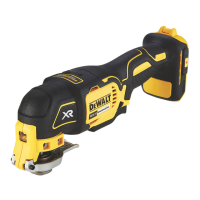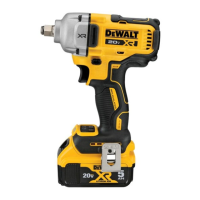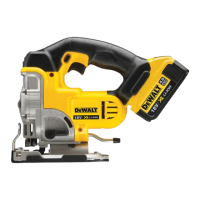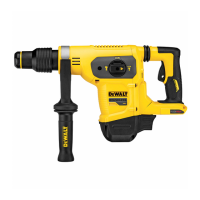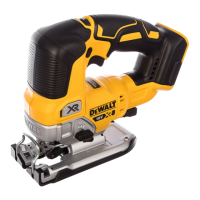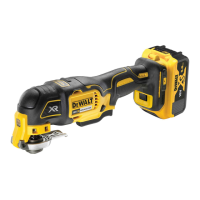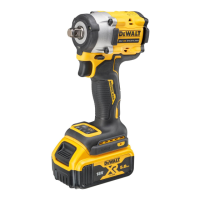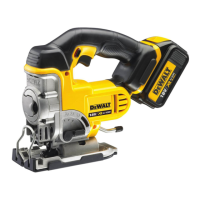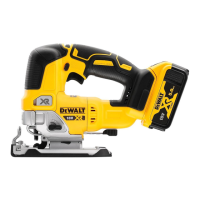8
ENGLISH
Chargers
DeWALT chargers require no adjustment and are designed to be
as easy as possible tooperate.
Electrical Safety
The electric motor has been designed for one voltage only.
Always check that the battery pack voltage corresponds to the
voltage on the rating plate. Also make sure that the voltage of
your charger corresponds to that of yourmains.
i
Your DeWALT charger is double insulated in
accordance with EN60335; therefore no earth wire
isrequired.
If the supply cord is damaged, it must be replaced only by
DeWALT or an authorised serviceorganisation.
Mains Plug Replacement
(U.K.& Ireland Only)
If a new mains plug needs to be fitted:
Residual Risks
In spite of the application of the relevant safety regulations
and the implementation of safety devices, certain residual risks
cannot be avoided. These are:
• Impairment ofhearing.
• Risk of personal injury due to flyingparticles.
• Risk of burns due to accessories becoming hot
duringoperation.
• Risk of personal injury due to prolongeduse.
• Risk of dust from hazardoussubstances.
Safety Warnings Specific for Wire Brushing
Operations
a ) Be aware that wire bristles are thrown by the brush
even during ordinary operation. Do not overstress
the wires by applying excessive load to the brush.
The wire bristles can easily penetrate light clothing and/
orskin.
b ) If the use of a guard is recommended for wire
brushing, do not allow any interference of the
wire wheel or brush with the guard. Wire wheel
or brush may expand in diameter due to work and
centrifugalforces.
Safety Warnings Specific for Sanding
Operations
a ) Do not use excessively oversized sanding disc
paper. Follow manufacturer’s recommendations,
when selecting sanding paper. Larger sanding paper
extending beyond the sanding pad presents a laceration
hazard and may cause snagging, tearing of the disc
orkickback.
Additional Safety Warnings Specific for
Abrasive Cutting-Off Operations
a ) Do not “jam” the cut‑off wheel or apply excessive
pressure. Do not attempt to make an excessive depth
of cut. Overstressing the wheel increases the loading and
susceptibility to twisting or binding of the wheel in the cut
and the possibility of kickback or wheelbreakage.
b ) Do not position your body in line with and behind
the rotating wheel. When the wheel, at the point of
operations, is moving away from your body, the possible
kickback may propel the spinning wheel and the power
tool directly atyou.
c ) When wheel is binding or when interrupting a cut
for any reason, switch off the power tool and hold
the power tool motionless until the wheel comes to a
complete stop. Never attempt to remove the cut‑off
wheel from the cut while the wheel is in motion
otherwise kickback may occur. Investigate and take
corrective action to eliminate the cause of wheelbinding.
d ) Do not restart the cutting operation in the
workpiece. Let the wheel reach full speed and
carefully re‑enter the cut. The wheel may bind, walk up
or kickback if the power tool is restarted in theworkpiece.
e ) Support panels or any oversized workpiece to
minimise the risk of wheel pinching and kickback.
Large workpieces tend to sag under their own
weight. Supports must be placed under the workpiece
near the line of cut and near the edge of the workpiece on
both sides of thewheel.
f ) Use extra caution when making a “pocket cut” into
existing walls or other blind areas. The protruding
An improperly mounted wheel that projects through the
plane of the guard lip cannot be adequatelyprotected.
c ) The guard must be securely attached to the power
tool and positioned for maximum safety, so the least
amount of wheel is exposed towards the operator.
The guard helps to protect the operator from broken wheel
fragments and accidental contact with wheel and sparks
that could igniteclothing.
d ) Wheels must be used only for recommended
applications. For example: do not grind with the side
of cut‑off wheel. Abrasive cut‑off wheels are intended
for peripheral grinding, side forces applied to these wheels
may cause them toshatter.
e ) Always use undamaged wheel flanges that are
of correct size and shape for your selected wheel.
Proper wheel flanges support the wheel thus
reducing the possibility of wheel breakage. Flanges
for cut‑off wheels may be different from grinding
wheelflanges.
f ) Do not use worn down wheels from larger power
tools. Wheel intended for larger power tool is not suitable
for the higher speed of a smaller tool and mayburst.
wheel may cut gas or water pipes, electrical wiring or
objects that can causekickback.
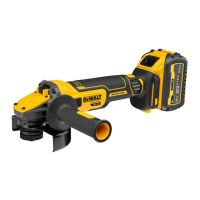
